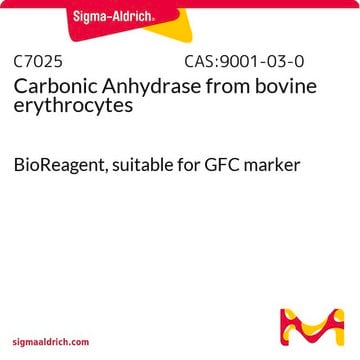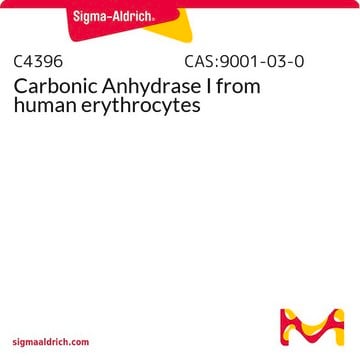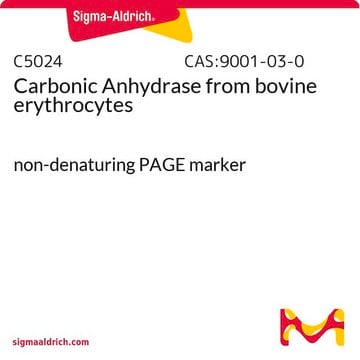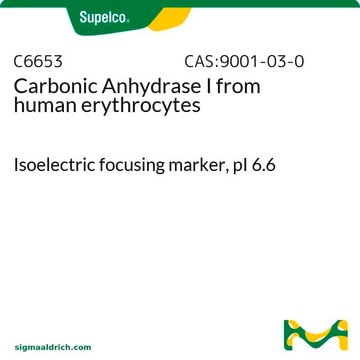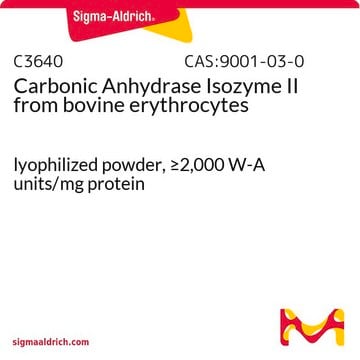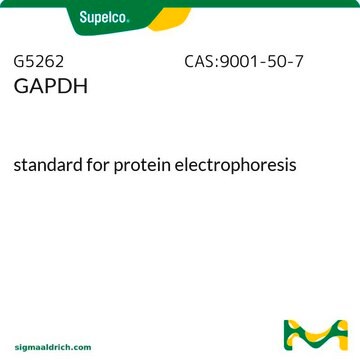C2273
Carbonic Anhydrase from bovine erythrocytes
For use as a marker in SDS-PAGE
Synonym(s):
Carbonate Dehydratase, Carbonate Hydrolyase
Sign Into View Organizational & Contract Pricing
All Photos(1)
About This Item
Recommended Products
biological source
bovine erythrocytes
Quality Level
form
powder
mol wt
~29 kDa
packaging
vial of 5 mg
storage temp.
2-8°C
Looking for similar products? Visit Product Comparison Guide
General description
Carbonic Anhydrase is a metalloenzyme with zinc. The active site of carbonic anhydrase contains three conserved histidine residues (His94, His96 and His119).
Application
Carbonic Anhydrase has been used:
- as a component of nine-protein mixture for the comparative proteomic mass spectrometry analysis of bovine brain samples
- as a molecular marker in gel filtration chromatography
- as a standard protein to test the recovery of CMA/20 microdialysis probe
Biochem/physiol Actions
Carbonic anhydrase is essential for the reversible hydration of carbon dioxide. It is also crucial for the physiological processes including respiration, ion transport, acid–base balance, lipid and carbohydrate metabolic pathways. Carbonic anhydrase participates in electrolyte secretion and in the carbon dioxide fixation.
Unit Definition
One collagen digestion unit (CDU) liberates peptides from collagen from bovine achilles tendon equivalent in ninhydrin color to 1.0 μmole of leucine in 5 hours at pH 7.4 at 37 °C.
Signal Word
Danger
Hazard Statements
Precautionary Statements
Hazard Classifications
Resp. Sens. 1
Storage Class Code
11 - Combustible Solids
WGK
WGK 3
Flash Point(F)
Not applicable
Flash Point(C)
Not applicable
Personal Protective Equipment
dust mask type N95 (US), Eyeshields, Gloves
Certificates of Analysis (COA)
Search for Certificates of Analysis (COA) by entering the products Lot/Batch Number. Lot and Batch Numbers can be found on a product’s label following the words ‘Lot’ or ‘Batch’.
Already Own This Product?
Find documentation for the products that you have recently purchased in the Document Library.
Customers Also Viewed
Alan J Rosenbloom et al.
Journal of neuroscience methods, 148(2), 147-153 (2005-07-27)
Unlike all other currently available sampling techniques, microdialysis allows the continuous recovery of dialysed fluid from the interstitial space of living tissue. Microdialysis has been extensively used to study small molecules such as neurotransmitters, metabolites and drugs in the brain
Md Imtaiyaz Hassan et al.
Bioorganic & medicinal chemistry, 21(6), 1570-1582 (2012-05-23)
The carbonic anhydrases enzymes (CAs, EC 4.2.1.1) are zinc containing metalloproteins, which efficiently catalyse the reversible conversion of carbon dioxide to bicarbonate and release proton. These enzymes are essentially important for biological system and play several important physiological and patho-physiological
Arun Devabhaktuni et al.
Journal of proteome research, 15(3), 732-742 (2016-01-09)
Dependent on concise, predefined protein sequence databases, traditional search algorithms perform poorly when analyzing mass spectra derived from wholly uncharacterized protein products. Conversely, de novo peptide sequencing algorithms can interpret mass spectra without relying on reference databases. However, such algorithms
Joana da Costa Ores et al.
Chemosphere, 88(2), 255-259 (2012-04-20)
This work presents a study of industrially applicable techniques to obtain a biologically supported carbon dioxide capture system, based on the extraction of carbonic anhydrase from bovine blood. Carbonic anhydrase is a metalloenzyme which catalyzes the reversible hydration of carbon
Fatima Gasset-Rosa et al.
Neuron, 102(2), 339-357 (2019-03-12)
While cytoplasmic aggregation of TDP-43 is a pathological hallmark of amyotrophic lateral sclerosis and frontotemporal dementia, how aggregates form and what drives its nuclear clearance have not been determined. Here we show that TDP-43 at its endogenous level undergoes liquid-liquid
Our team of scientists has experience in all areas of research including Life Science, Material Science, Chemical Synthesis, Chromatography, Analytical and many others.
Contact Technical Service

